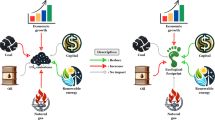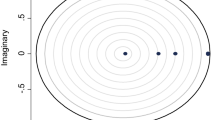Abstract
Carbon emissions have turned out to be one of the key alarming and complex issues which drive a long-lasting debate over climate change. The increasing trend in the usage of fossil fuels for the curse of economic development and at the same time reducing carbon emissions has become a significant phenomenon worldwide. In this study, we evaluate carbon emissions (CO2) during 1972–2016 by employing logarithmic mean Divisia index (LMDI) method. The results from decomposition using LMDI method indicate that the economic development factor is the main driving force for the increase of per capita carbon emissions in the country; the energy structure and energy efficiency are the restraining factor for per capita carbon emissions. Therefore, Pakistan should continue to upgrade energy structure from traditional sources to renewable energy sources to curb the increase of carbon emissions, and also, improve the efficiency of energy use and save energy to cope with environmental challenges. Finally, the study concludes with some policy suggestions.






Similar content being viewed by others
References
Ali R, Bakhsh K, Yasin MA (2019) Impact of urbanization on CO2 emissions in emerging economy: evidence from Pakistan. Sustain Cities Soc 48:101553
Ang BW (2004) Decomposition analysis for policymaking in energy: which is the preferred method? Energy Policy 32(9):1131–1139
Ang BW, Choi K-H (1997) Decomposition of aggregate energy and gas emission intensities for industry: a refined Divisia index method. Energy J:59–73
Ang, Liu N (2007) Energy decomposition analysis: IEA model versus other methods. Energy Policy 35(3):1426–1432
Ang B, Huang H, Mu A (2009) Properties and linkages of some index decomposition analysis methods. Energy Policy 37(11):4624–4632
Attari MIJ, Hussain M, Javid AY (2016) Carbon emissions and industrial growth: an ARDL analysis for Pakistan. Int J Energy Sect Manag 10(4):642–658
Bakhsh K, Rose S, Ali MF, Ahmad N, Shahbaz M (2017) Economic growth, CO2 emissions, renewable waste and FDI relation in Pakistan: new evidences from 3SLS. J Environ Manag 196:627–632
Balcilar M, Ozdemir ZA, Arslanturk Y (2010) Economic growth and energy consumption causal nexus viewed through a bootstrap rolling window. Energy Econ 32(6):1398–1410
Butnar I, Llop M (2011) Structural decomposition analysis and input–output subsystems: changes in CO2 emissions of Spanish service sectors (2000–2005). Ecol Econ 70(11):2012–2019
Cansino JM, Sánchez-Braza A, Rodríguez-Arévalo ML (2015) Driving forces of Spain’s CO2 emissions: a LMDI decomposition approach. Renew Sust Energ Rev 48:749–759
Cansino JM, Román R, Ordonez M (2016) Main drivers of changes in CO2 emissions in the Spanish economy: a structural decomposition analysis. Energy Policy 89:150–159
Chen P-Y, Chen S-T, Chen C-C (2012) Energy consumption and economic growth—new evidence from meta analysis. Energy Policy 44:245–255
Donglan Z, Dequn Z, Peng Z (2010) Driving forces of residential CO2 emissions in urban and rural China: an index decomposition analysis. Energy Policy 38(7):3377–3383
Elahi E, Weijun C, Jha SK, Zhang H (2019) Estimation of realistic renewable and non-renewable energy use targets for livestock production systems utilising an artificial neural network method: a step towards livestock sustainability. Energy
Finance, M. o (2018) Pakistan Economic Survey 2016–17 Retrieved 25-November-2018, from www.finance.gov.pk/survey/chapters_17/Pakistan_ES_2016_17_pdf.pdf. Accessed 25 Nov 2018.
Gao T, Selinger JL, Rochelle GT (2019) Demonstration of 99% CO2 removal from coal flue gas by amine scrubbing. Int J Greenh Gas Control 83:236–244
Guan D, Liu Z, Geng Y, Lindner S, Hubacek K (2012) The gigatonne gap in China’s carbon dioxide inventories. Nat Clim Chang 2(9):672
Hatzigeorgiou E, Polatidis H, Haralambopoulos D (2008) CO2 emissions in Greece for 1990–2002: a decomposition analysis and comparison of results using the arithmetic mean Divisia index and logarithmic mean Divisia index techniques. Energy 33(3):492–499
Hübler M, Voigt S, Löschel A (2014) Designing an emissions trading scheme for China—an up-to-date climate policy assessment. Energy Policy 75:57–72
Hussain M, Irfan Javaid M, Drake PR (2012) An econometric study of carbon dioxide (CO2) emissions, energy consumption, and economic growth of Pakistan. Int J Energy Sect Manag 6(4):518–533
Irfan M, Riaz M, Arif MS, Shahzad SM, Saleem F, van den Berg L, Abbas F (2014) Estimation and characterization of gaseous pollutant emissions from agricultural crop residue combustion in industrial and household sectors of Pakistan. Atmos Environ 84:189–197
Jawed A, Talpur M, Chandio I, Mahesar P (2019) Impacts of in-accessible and poor public transportation system on urban environment: evidence from Hyderabad, Pakistan. Eng Technol Appl Sci Res 9(2):3896–3899
Khan MM, Zaman K, Irfan D, Awan U, Ali G, Kyophilavong P et al (2016) Triangular relationship among energy consumption, air pollution and water resources in Pakistan. J Clean Prod 112:1375–1385
Khan M, Chaudhry MN, Ahmad SR, Saif S (2019) The role of and challenges facing non-governmental organizations in the environmental impact assessment process in Punjab, Pakistan. Impact Assessment and Project Appraisal:1–14. https://doi.org/10.1080/14615517.2019.1684096
Khan MK, Teng J-Z, Khan MI (2019a) Effect of energy consumption and economic growth on carbon dioxide emissions in Pakistan with dynamic ARDL simulations approach. Environ Sci Pollut Res:1–11
Khan MK, Teng J-Z, Khan MI, Khan MO (2019b) Impact of globalization, economic factors and energy consumption on CO2 emissions in Pakistan. Sci Total Environ 688:424–436
Li JF, Wang X, Zhang YX (2012) Is it in China’s interest to implement an export carbon tax? Energy Econ 34(6):2072–2080
Lim H-J, Yoo S-H, Kwak S-J (2009) Industrial CO2 emissions from energy use in Korea: a structural decomposition analysis. Energy Policy 37(2):686–698
Lin B, Ahmad I (2017) Analysis of energy related carbon dioxide emission and reduction potential in Pakistan. J Clean Prod 143:278–287
Lin B, Xie X (2016) CO2 emissions of China’s food industry: an input–output approach. J Clean Prod 112:1410–1421
Liu L-C, Fan Y, Wu G, Wei Y-M (2007) Using LMDI method to analyze the change of China’s industrial CO2 emissions from final fuel use: an empirical analysis. Energy Policy 35(11):5892–5900
Liu Y, Kumail T, Ali W, Sadiq F (2019) The dynamic relationship between CO2 emission, international tourism and energy consumption in Pakistan: a cointegration approach. Tourism Review
Meng M, Niu D, Shang W (2014) A small-sample hybrid model for forecasting energy-related CO2 emissions. Energy 64:673–677
Meng M, Jing K, Mander S (2017) Scenario analysis of CO2 emissions from China’s electric power industry. J Clean Prod 142:3101–3108
Mirza FM, Kanwal A (2017) Energy consumption, carbon emissions and economic growth in Pakistan: dynamic causality analysis. Renew Sust Energ Rev 72:1233–1240
Mohiuddin O, Asumadu-Sarkodie S, Obaidullah M (2016) The relationship between carbon dioxide emissions, energy consumption, and GDP: a recent evidence from Pakistan. Cogent Engineering 3(1):1210491
Nasir M, Rehman FU (2011) Environmental Kuznets curve for carbon emissions in Pakistan: an empirical investigation. Energy Policy 39(3):1857–1864
Pakistan, S. B. o (2017) Handbook of Statistics on Pakistan Economy 2015. Retrieved 25-October-2018, 2018, from http://www.sbp.org.pk/departments/stats/PakEconomy_HandBook/index.htm. Accessed 25 Oct 2018.
Shahzad SJH, Kumar RR, Zakaria M, Hurr M (2017) Carbon emission, energy consumption, trade openness and financial development in Pakistan: a revisit. Renew Sust Energ Rev 70:185–192
Shan Y, Liu J, Liu Z, Xu X, Shao S, Wang P, Guan D (2016) New provincial CO2 emission inventories in China based on apparent energy consumption data and updated emission factors. Appl Energy 184:742–750
Tan X, Lai H, Gu B, Zeng Y, Li H (2018) Carbon emission and abatement potential outlook in China’s building sector through 2050. Energy Policy 118:429–439
Wang H, Ang B (2018) Assessing the role of international trade in global CO2 emissions: an index decomposition analysis approach. Appl Energy 218:146–158
Wang W, Zhang M, Zhou M (2011) Using LMDI method to analyze transport sector CO2 emissions in China. Energy 36(10):5909–5915
Wang Z, Zhang B, Wang B (2018) Renewable energy consumption, economic growth and human development index in Pakistan: evidence form simultaneous equation model. J Clean Prod 184:1081–1090
Wang R, Liu S, Wang L, Li Q, Zhang S, Chen B et al (2019a) Superior energy-saving splitter in monoethanolamine-based biphasic solvents for CO2 capture from coal-fired flue gas. Appl Energy 242:302–310
Wang S, Fang C, Sun L, Su Y, Chen X, Zhou C et al (2019b) Decarbonizing China’s urban agglomerations. Ann Am Assoc Geogr 109(1):266–285
Wang Z, Asghar MM, Zaidi SAH, Wang B (2019c) Dynamic linkages among CO 2 emissions, health expenditures, and economic growth: empirical evidence from Pakistan. Environ Sci Pollut Res 26(15):15285–15299
Wei J, Huang K, Yang S, Li Y, Hu T, Zhang Y (2017) Driving forces analysis of energy-related carbon dioxide (CO2) emissions in Beijing: an input–output structural decomposition analysis. J Clean Prod 163:58–68
Xu X, Ang BW (2013) Index decomposition analysis applied to CO2 emission studies. Ecol Econ 93:313–329
Xu M, Li R, Crittenden JC, Chen Y (2011) CO2 emissions embodied in China’s exports from 2002 to 2008: a structural decomposition analysis. Energy Policy 39(11):7381–7388
Yao C, Feng K, Hubacek K (2015) Driving forces of CO2 emissions in the G20 countries: an index decomposition analysis from 1971 to 2010. Eco Inform 26:93–100
Yasmeen H, Wang Y, Zameer H (2019a) Modeling the role of government, firm, and civil society for environmental sustainability. Int J Agric Environ Inf Syst (IJAEIS) 10(2):82–97
Yasmeen H, Wang Y, Zameer H, Solangi YA (2019b) Does oil price volatility influence real sector growth? Empirical evidence from Pakistan. Energy Rep 5:688–703
Zameer H, Wang Y (2018) Energy production system optimization: evidence from Pakistan. Renew Sust Energ Rev 82:886–893
Zhang W, Li K, Zhou D, Zhang W, Gao H (2016) Decomposition of intensity of energy-related CO2 emission in Chinese provinces using the LMDI method. Energy Policy 92:369–381
Zhang B, Wang Z, Wang B (2018) Energy production, economic growth and CO 2 emission: evidence from Pakistan. Nat Hazards 90(1):27–50
Author information
Authors and Affiliations
Corresponding author
Additional information
Responsible editor: Muhammad Shahbaz
Publisher’s note
Springer Nature remains neutral with regard to jurisdictional claims in published maps and institutional affiliations.
Rights and permissions
About this article
Cite this article
Yasmeen, H., Wang, Y., Zameer, H. et al. Decomposing factors affecting CO2 emissions in Pakistan: insights from LMDI decomposition approach. Environ Sci Pollut Res 27, 3113–3123 (2020). https://doi.org/10.1007/s11356-019-07187-3
Received:
Accepted:
Published:
Issue Date:
DOI: https://doi.org/10.1007/s11356-019-07187-3




